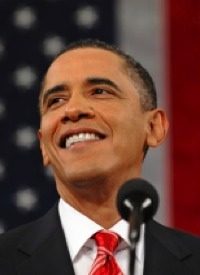
President Barack Obama’s “State of the Union” address included a wide array of promises for new spending programs and tax cuts despite a record $1.35 trillion deficit projected for the current fiscal year.
Obama’s “State of the Union” address included 10 new proposals for increased spending:
• “Take $30 billion of the money Wall Street banks have repaid and use it to help community banks give small businesses the credit they need to stay afloat.”
• “Put more Americans to work building clean energy facilities.”
• “To create more of these clean energy jobs, we need more production, more efficiency, more incentives.”
• “Incentives for energy efficiency and clean energy are the right thing to do for our future.”
• “It means continued investment in advanced biofuels and clean coal technologies.”
• “We’re launching a National Export Initiative. ”
• “We need to invest in the skills and education of our people.”
• “I urge the Senate to follow the House and pass a bill that will revitalize our community colleges.”
• “To make college more affordable, this bill will finally end the unwarranted taxpayer-subsidies that go to banks for student loans. Instead, let’s take that money and give families a $10,000 tax credit for four years of college and increase Pell Grants.”
• “Another 1 million students … when they graduate … will be required to pay only 10 percent of their income on student loans, and all of their debt will be forgiven after 20 years — and forgiven after 10 years if they choose a career in public service.”
Tax Cuts
President Obama also stressed that his earlier proposals cut taxes: “We cut taxes for 95 percent of working families. We cut taxes for small businesses. We cut taxes for first-time homebuyers. We cut taxes for parents trying to care for their children. We cut taxes for 8 million Americans paying for college.” In addition, he called for six more tax cuts in his speech:
• “Eliminate all capital gains taxes on small business investment.”
• “Put Americans to work today building the infrastructure of tomorrow.”
• “Give rebates to Americans who make their homes more energy efficient, which supports clean energy jobs.”
• “We’re nearly doubling the child care tax credit.”
• “Expanding the tax credit for those who start a nest egg.”
• “This year, we will step up re-financing so that homeowners can move into more affordable mortgages.”
If that combination of new spending programs and tax cuts indicates that the near-record gap between spending and revenue will expand even more, President Obama doesn’t want Americans to fear. He claims that in his search for spending cuts “we’ve already identified $20 billion in savings for next year.” That’s less than the price tag of his first new spending item alone in his laundry list of spending proposals. But he’s got another proposal for fiscal “discipline,” a spending freeze:
So tonight, I’m proposing specific steps to pay for the $1 trillion that it took to rescue the economy last year. Starting in 2011, we are prepared to freeze government spending for three years. Spending related to our national security, Medicare, Medicaid and Social Security will not be affected, but all other discretionary government programs will…. And if I have to enforce this discipline by veto, I will.
Of course, this so-called “freeze” would not touch some 82 percent of federal spending. Moreover, the “freeze” would not be an across-the-board “freeze” of even that meager portion of “non-defense discretionary spending,” as the term is called. It’s probably worth noting that much of the current deficit was racked up while the Bush administration, and its compliant GOP Congress kept non-defense discretionary spending to near-zero growth levels. The four programs Obama mentioned are the ones increasing geometrically and in dire need of serious spending cuts.
But even this meager “freeze” measure does not live up to its billing. It’s not an across-the-board freeze. Obama would allow dramatic increases within those non-defense discretionary categories, as long as other programs are proportionately cut. And none of it would start until after the next election and all of the “stimulus” spending raises the spending bar further:
I know that some in my own party will argue that we can’t address the deficit or freeze government spending when so many are still hurting. I agree, which is why this freeze won’t take effect until next year, when the economy is stronger. That’s how budgeting works.
That is, apparently, how budgeting works in the Obama administration. He titled his first budget, for fiscal 2010 “A New Era of Responsibility.” And the non-partisan Congressional Budget Office has labeled his deficit spending ways “unsustainable.” The CBO’s January report this month noted: “Under current law, the federal fiscal outlook beyond this year is daunting: Projected deficits average about $600 billion per year over the 2011–2020 period despite an anticipated economic recovery, albeit a slow and tentative one.” That’s a deficit level even with the CBO’s supersonic growth projection of 4.4 percent after 2011.
Meanwhile, the White House’s Office of Management and Budget is still boasting of it’s fiscal management that “The First Cuts Are the Deepest” in a January 14 blog item, patting themselves for finding a mere $17 billion in fat last year that they persuaded Congress to eliminate. That amount was less than two percent of the increase in the deficit President Obama has admitted to causing.
President Obama made it clear in his “State of the Union” address January 27 that he plans to spend and tax-cut his way out of the deficit. His speech was a laundry list — actually, a Christmas list — of promises on which he can’t deliver without increasing the deficit further. This is precisely the strategy used by many neo-conservative Republicans who argued four years ago that deficits don’t matter.
The question is, will the American people fall for the same neo-conservative line once again under a Democrat? During the height of Roosevelt’s New Deal in the 1930s, “Brain trust” member Harry Hopkins told business leaders at a race track that FDR’s recovery strategy was “Tax and tax, spend and spend, elect and elect.” Newspapers also quoted him as saying that the “people are just too damned dumb to understand” about critics of New Deal-era arts funding. The two quotes got melded in the heat of the era, and popularly became: “Tax and tax, spend and spend, elect and elect, the people are just too damned dumb to understand.”
President Obama’s “State of the Union” agenda could be summed up by Harry Hopkins as: “Tax-cut and tax-cut, spend and spend, bigger deficits and bigger deficits, the people are just too damned dumb to understand.”



